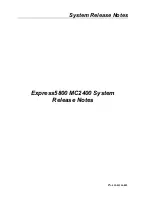
Disk Management
66
NAS 2000s Administration Guide
■
When managing basic disks, only the last partition on the disk can be extended unless the
disk is changed to dynamic.
■
Basic disks can be converted to dynamic without bringing the system offline or loss of
data, but the volume will be unavailable during the conversion.
■
Basic disks can contain up to four primary partitions (or three primary partitions and one
extended partition).
■
Format drives with a 16 K allocation size for best support of snapshots, performance, and
defragmentation.
■
NTFS formatted drives are recommend since they provide the greatest level of support for
snapshots, encryption, and compression.
■
Only basic disks can be formatted as FAT or FAT32.
Volumes Page
On the Volumes page, administrators can select to manage volumes, schedule
defragmentation, and set or manage quotas. The Volumes page displays all volumes that are
formatted NTFS on the system. It does not display the volume type (for example simple or
spanned) nor volumes that are FAT32 or FAT. To display these types of volumes, click the
Manage or Advanced Disk Management buttons.
See the Managed Disks page to view a list of disks, and the volumes assigned to them. The
drive letters for volumes that encompass multiple disks appear on multiple rows on the display.
For an example, see the volume labeled H: in
Summary of Contents for 345646-001 - StorageWorks NAS 2000s External Storage Server
Page 16: ...About this Guide 16 NAS 2000s Administration Guide ...
Page 56: ...Storage Management Overview 56 NAS 2000s Administration Guide ...
Page 80: ...Disk Management 80 NAS 2000s Administration Guide ...
Page 110: ...User and Group Management 110 NAS 2000s Administration Guide ...
Page 146: ...Folder Printer and Share Management 146 NAS 2000s Administration Guide ...
Page 186: ...NetWare File System Management 186 NAS 2000s Administration Guide ...
















































